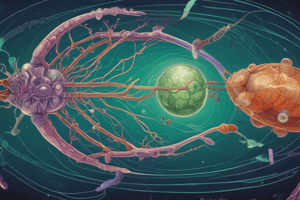Podcast
Questions and Answers
Which subfield of biology primarily focuses on the fundamental units of life?
Which subfield of biology primarily focuses on the fundamental units of life?
What is the main focus of genetics in terms of study?
What is the main focus of genetics in terms of study?
Which biology subfield investigates the relationships between organisms and their environments?
Which biology subfield investigates the relationships between organisms and their environments?
What aspect of life does evolution primarily shed light on?
What aspect of life does evolution primarily shed light on?
Signup and view all the answers
In biology, what field examines the intricate pathways through which information flows within cells?
In biology, what field examines the intricate pathways through which information flows within cells?
Signup and view all the answers
Which field of biology focuses on the change in the genetic makeup of populations over generations?
Which field of biology focuses on the change in the genetic makeup of populations over generations?
Signup and view all the answers
What branch of biology deals with the structure of living organisms at different scales?
What branch of biology deals with the structure of living organisms at different scales?
Signup and view all the answers
Which subfield of biology helps explain how animals, plants, and microorganisms have adapted to their environments over time?
Which subfield of biology helps explain how animals, plants, and microorganisms have adapted to their environments over time?
Signup and view all the answers
What aspect of biology examines the intricate balance that sustains life on Earth?
What aspect of biology examines the intricate balance that sustains life on Earth?
Signup and view all the answers
Which branch of biology looks at tissues, cells, and molecules to understand the structure and systems of living organisms?
Which branch of biology looks at tissues, cells, and molecules to understand the structure and systems of living organisms?
Signup and view all the answers
Study Notes
Introduction to Biology Subtopics
Biology, the study of life, encompasses various aspects that deal with the functioning, growth, reproduction, and adaptation of organisms. To gain a comprehensive understanding of life's processes, we delve into five essential subfields: cell biology, genetics, ecology, evolution, and anatomy. Each of these subtopics provides insights into different layers of life, from atomic structures to ecosystem dynamics and the grand sweep of species development over time.
Cell Biology
At the heart of every living thing are cells, the fundamental units of life responsible for carrying out essential tasks. Cell biology studies these tiny entities, examining their structure, function, and interactions with their environment. From understanding how cells reproduce to deciphering the intricate pathways through which information flows, cell biology sheds light on the building blocks of life itself.
Genetics
Genetics is concerned with the transmission of traits from parents to offspring. It is the study of genes, the molecular blueprints that determine inherited characteristics. By exploring how genetic information is encoded, transmitted, expressed, and regulated, we uncover the underlying basis of heredity and variation among living beings.
Ecology
Ecology studies the relationships between organisms and their environments. This includes examining how populations interact with each other and with abiotic factors like climate, soil, and water. Ecology provides insights into the intricate balance that sustains life on Earth, helping us better manage resources and protect our planet.
Evolution
Evolution is the change in the genetic makeup of populations over generations. Through observation and experimentation, evolutionary biologists seek to explain how animals, plants, and microorganisms have changed over time to adapt to their environments. This subfield provides critical insights into why certain species look and behave the way they do today.
Anatomy
Anatomy is the branch of biology that deals with the structure of living organisms. It covers both gross anatomy, which deals with large-scale structures visible to the naked eye, and microscopic anatomy, which looks at tissues, cells, and molecules. Understanding the anatomical structures and systems of organisms allows scientists to unravel how life works at different scales and across diverse forms of life.
Each of these subtopics contributes to our overall understanding of life, helping us piece together the complexity of living organisms. Together, they constitute a multifaceted discipline that continues to evolve as we discover more about the wonders of life on Earth.
Studying That Suits You
Use AI to generate personalized quizzes and flashcards to suit your learning preferences.
Description
Explore the fundamental subfields of biology through this quiz, covering cell biology, genetics, ecology, evolution, and anatomy. Test your knowledge on the structure of cells, the transmission of traits, relationships between organisms and their environments, the genetic makeup of populations over generations, and the anatomical structures of living organisms.




